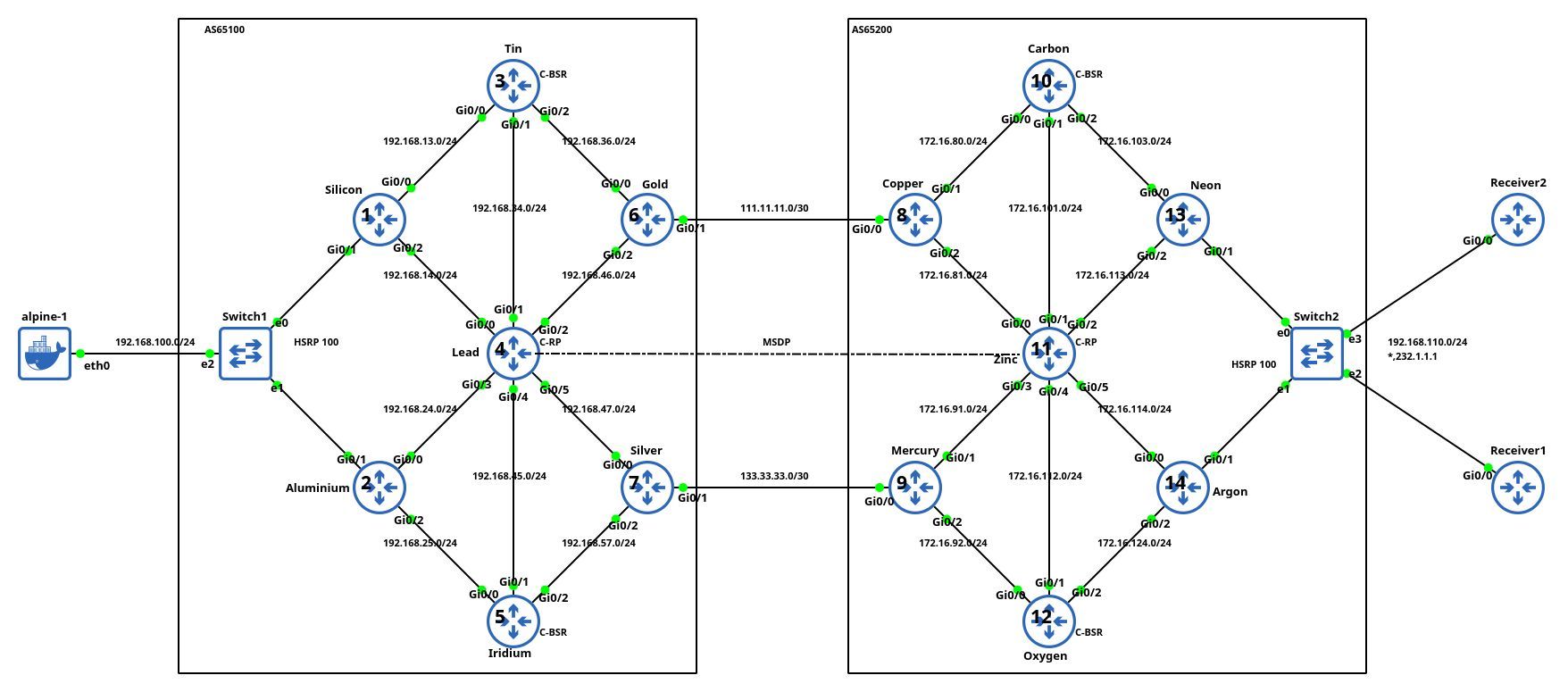netlab 25.12: Cisco IOS/XR Configuration Modules, More VXLAN Goodies
netlab release 25.12 (25.12.02 to be exact – I had a few PEBCAK moments) was published last Friday. Here are the highlights:
- Significantly improved Cisco IOS/XR support. With the netlab release 25.12, you can configure VLANs, VRFs, static routes, route redistribution, OSPF default routes, BGP confederations, and BGP local-as
- VXLAN-over-IPv6 on Arista EOS
- VXLAN with ingress replication on Cisco Catalyst 8000v
- The shutdown link/interface attribute can be used to start labs with interfaces turned off
- Large BGP community lists, implemented on Arista EOS, FRR, and Junos. You can use standard- or large community lists in routing policies
- The netlab validate command will reread validation tests from a modified lab topology file every time you run it. It can also read validation tests from a separate file.
Lab: More Complex VXLAN Deployment Scenario
In the first VXLAN lab, we covered the very basics. Now it’s time for a few essential concepts (before introducing the EVPN control plane or integrated routing and bridging):
- Each VXLAN segment could have a different set of VTEPs (used to build the BUM flooding list)
- While the VXLAN Network Identifier (VNI) must be unique across the participating VTEPs, you could map different VLAN IDs into a single VNI (allowing you to merge two VLAN segments over VXLAN)
- Neither VXLAN VNI nor VLAN ID has to be globally unique (but it helps to make them unique to remain sane)
Technical Writing: Lower Your Expectations
Sean Goedecke published an excellent set of recommendations for good technical writing, including:
- Keep it short
- Try to make your point in the first sentence
- Details matter less than you think.
Based on some emails I received in the past (and the lack of response to the lengthy emails I sent), we should apply the same rules to emails (and all other forms of technical communication).
Worth Watching: AI/ML Data Center Design
What could be better than watching 0x02 Jeffs discuss networking? How about having Petr Lapukhov of the RFC 7938 fame as a guest discussing AI/ML Data Center Design?
Note: Petr disappeared into the information black hole called Facebook over a decade ago, so I wondered how they allowed him to chat on a podcast for hours. It turns out he moved to NVIDIA, which might influence the podcast content a bit, but I’m pretty sure Petr is still Petr ;)
Multi-Pod EVPN Troubleshooting (Part 3)
Last week, we fixed the mismatched route targets in our sample multi-pod EVPN fabric. With that fixed, every PE device should see every other PE device as a remote VTEP for ingress replication purposes. We got that to work on Site-A (AS 65001), but not on Site-B (AS 65002); let’s see what else is broken.
Note: This is the fifth blog post in the Multi-Pod EVPN series. If you stumbled upon it, start with the design overview and troubleshooting overview posts. More importantly, familiarize yourself with the topology we’ll be using; it’s described in the Multi-Pod EVPN Troubleshooting: Fixing Next Hops.
Ready? Let’s go. Here’s our network topology:
netlab as the Universal Configuration Translator
Dan Partelly, a heavy netlab user (and an active contributor), sent me this interesting perspective on how one might want to use netlab without ever building a lab with it. All I added was a bit of AI-assisted editing; my comments are on a grey background.
In all podcasts and interviews I listened to, netlab was referred to as a “lab management solution”. But this is misleading. It’s also a translator, due to its ability to abstract devices, and can easily generate perfectly usable configs for devices or technologies you have never worked on.
Fun Reading: From XML to LLMs
In his latest blog post (Systems design 3: LLMs and the semantic revolution), Avery Pennarun claims that LLMs might solve the problem we consistently failed to solve on a large scale for the last 60 (or so) years – the automated B2B data exchange.
You might agree with him or not (for example, an accountant or two might get upset with hallucinated invoice items), but his articles are always a fun read.
Lab: IS-IS Route Redistribution
Route redistribution into IS-IS seems even easier than its OSPFv2/OSPFv3 counterparts. There are no additional LSAs/LSPs; the redistributed prefixes are included in the router LSP. Things get much more interesting once you start looking into the gory details and exploring how different implementations use (or do not) the various metric bits and TLVs.
You’ll find more details (and the opportunity to explore the LSP database contents in a safe environment) in the IS-IS Route Redistribution lab exercise.

Click here to start the lab in your browser using GitHub Codespaces (or set up your own lab infrastructure). After starting the lab environment, change the directory to feature/7-redistribute and execute netlab up.
OSPFv3 Router ID Documentation on Arista EOS
When I published a blog post making fun of the ridiculously incorrect Cisco IOS/XE OSPFv3 documentation, an engineer working for Cisco quickly sent me an email saying, “Well, the other vendors are not much better.”
Let’s see how well Arista EOS is doing; this is their description of the router-id command (taken from EOS 4.35.0F documentation; unchanged for at least a dozen releases):

Testing IP Multicast with netlab
Aleksandr Albin built a large (almost 20-router) lab topology (based on an example from Jeff Doyle’s Routing TCP/IP Volume 2) that he uses to practice inter-AS IP multicast. He also published the topology file (and additional configuration templates) on GitHub and documented his experience in a LinkedIn post.

Lab topology, copied with permission by Aleksandr Albin
It’s so nice to see engineers using your tool in real-life scenarios. Thanks a million, Aleksandr, for sharing it.
Multi-Pod EVPN Troubleshooting (Route Targets)
Last week, we fixed the incorrect BGP next hops in our sample multi-pod EVPN fabric. With that fixed, every PE device should see every other PE device as a remote VTEP for ingress replication purposes. However, that’s not the case; let’s see why and fix it.
Note: This is the fourth blog post in the Multi-Pod EVPN series. If you stumbled upon it, start with the design overview and troubleshooting overview posts. More importantly, familiarize yourself with the topology we’ll be using; it’s described in the Multi-Pod EVPN Troubleshooting: Fixing Next Hops.
Ready? Let’s go. Here’s our network topology:
IOS/XR Route Redistribution Configuration Mess
One would hope that the developers of a network operating system wouldn’t feel the irresistible urge to reinvent what should have been a common configuration feature for every routing protocol. Alas, the IOS/XR developers failed to get that memo.
I decided to implement route redistribution (known as route import in netlab) for OSPFv2/OSPFv3, IS-IS, and BGP on IOS/XR (Cisco 8000v running IOS/XR release 24.4.1) and found that each routing protocol uses a different syntax for the source routing protocol part of the redistribute command.
Public Videos: Bridging with EVPN

The EVPN in the Data Center and Bridging with EVPN parts of the EVPN webinar, featuring Dinesh Dutt, are now available without a valid ipSpace.net account. Enjoy!
Building VXLAN/EVPN Data Center Lab with netlab
Dmitry Klepcha published an excellent document describing how you can use netlab to build a series of data center fabric labs, starting from a simple IP network (without routing) and finishing with a complex EVPN/VXLAN network using symmetric IRB and MLAG toward hosts.
But wait, there’s more: all the lab topologies he used in his exercises are available on GitHub, which means that you could just clone the repo and start using them (I also “borrowed” some of his ideas as future netlab improvements).
Finally, thanks a million to Roman Pomazanov for bringing Dmitry’s work to my attention (and for the quote at the end of his post ;).
Interesting: an MCP Agent for Link-State Routing Protocols
Vadim Semenov created a nice demo that allows you to use an LLM to query the collected link-state graphs through an MCP agent (SuzieQ would probably be faster and easier to deploy, but hey, AI).
If you want to kick the tires, you’ll find the source code on GitHub (Network AI assistant, MCP server for Topolograph service). You’ll also need Vadim’s previous projects: Topolograph and OSPF watcher or IS-IS watcher.
